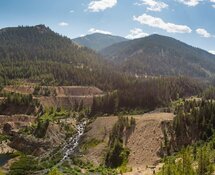TW: Absolutely. Two of my standout companies are Capital Gold Corp. (TSX:CGC;OTCBB:CGLD; Frankfurt:CGU) and Fortuna Silver Mines Inc. (TSX.V:FVI), due to their impressive profitability. Capital Gold produced about 50,000 ounces in their year ending July 31 and reported over $10 million in fully taxed net profits. John Brownlie, who has been with the company since 2006, was just made President and COO in September. He is arguably one of the best operators amongst the juniors. He built the El Chanate mine in Sonora on time and on budget. It is now one of the lowest cost mines in the industry with a cash cost of just $330. Its reserves have grown from about 400,000 proven and probable (2P) ounces when the mine was built to more than 1.5 million 2P ounces today. They have just installed a new crusher module and built a second leach pad. They should produce about 70,000 ounces in calendar 2010. The residual leaching from the old pad could add another 20,000 ounces. They are unhedged and at current gold prices will generate cash flow of about $40 million. The stock is selling at less than five times calendar 2010 cash flow and less than eight times earnings.
Fortuna is another well-managed company. Their production and profitability profile is based on their Caylloma Mine in Peru, but they have a very exciting project—San Jose—in Oaxaca State. They have built an impressive resource and begun mine construction. San Jose will be mostly financed from their treasury and from cash flow from Caylloma. We were set to visit the property last June, but had to cancel due to the H1N1 flu outbreak. I am looking forward to seeing this project this spring.
TGR: In Part I, you mentioned adding Oro Gold Resources Ltd. (TSX-V:OGR) and Rochester Resources Ltd. (TSX-V:RCT) to the model. What stage are these companies in? Early Explorers, Advanced Explorers or Producing Explorers?
TW: I added Oro Gold to the Early Explorers category, and have Rochester in the Advanced Explorers category. If you look at the model itself, there are stated criteria that can move a company from one category to another. To some degree, though, a bit of it is subjective. For instance, I don't move an Early Explorer up just based on the resource and having a 43-101 resource. Those are among the criteria, but if I see some stumbling blocks in the development or feel they aren't making enough progress moving a project toward economic feasibility I won't move them up. For example, if they still have a lot to do in the way of metallurgical testing, dealing with access and surface rights issues and water issues and other potential permitting problems, I may keep them in the Early category even if they have a bigger resource than some Advanced Explorers.
TGR: You say Rochester is an Advanced Explorer? Aren't they producing?
TW: Rochester does have some production, but it's very small so far. They have had issues with feeding their mill from narrow underground veins. They have just raised some capital and have a new mine plan and exploration program. I look for the company to move up to the Producing Explorers category as their story unfolds this year when they really ramp up production and start showing earnings or at least cash flow. So this was a bit of a selective placement on my part, but it allows me to move them up and alert my clients that they are executing. One of the exciting things at Rochester is that Eduardo Luna is now President and CEO. He was Goldcorp's president of Mexican operations (Luismin) and is one of the most respected mining names in Mexico. He could have picked from many companies in Mexico to run. He chose Rochester and put his own money in the deal. I always like management with "skin in the game." Eduardo's goal is to grow production and resources at Mina Real, which is in Nayarit State, in the same way he built mines for Luismin.
TGR: Have you added anything else to the model lately?
TW: In addition to Oro Gold and Rochester Resources, I've recently added Silvermex Resources Ltd. (TSX-V: SMR) to the Advanced Explorers. Silvermex is a new management story. CEO Duane Nelson has just brought on Mike Callahan and Art Brown to help him manage the company. These are retired Hecla executives who could make this a very exciting story in 2010. Duane also added two new board members, Joe Ovsenek and Ken McNaughton. They both work for Silver Standard (TSX: SSO; Nasdaq: SSRI) and have been involved many significant discoveries and mine developments. This quality of people doesn't get involved in a junior company unless they really see something they like.
Silvermex has an option on the San Marcial property, a near-surface deposit of over 20 million ounces of high- grade silver in Sinaloa State. They also just bought the old Rosario Mine from Aurcana Corporation. This is a mine that was operated by Grupo Mexico in the 1990s and was shut down due to labor issues and low metal prices. The infrastructure at Rosario will allow Silvermex to fast-track San Marcial into production. There is also a couple of years' worth of production left behind by Grupo at Rosario that is very economical. There is significant exploration potential at the old mine, at San Marcial and within the district. Either of these projects on their own may not have been developable without a lot more exploration, but together they make a very powerful story and a near-term silver producer.
TGR: What's the Oro Gold story?
TW: Oro Gold is managed by a group who worked for Placer Dome. They are very smart and have a project outside of Mazatlan called Trinidad. This is an old Eldorado Mine that is very difficult rock to drill, but I think the Oro Gold people are figuring out the deposit and it is going to be pretty big. The grades and widths are very impressive.
TGR: Would you give us updates on some of the other companies in your model?
TW: Sure. Great Panther Silver Limited (TSX:GPR) has done a lot of drilling at their Guanajuato Mines and they're seeing some very good grades and widths. But it's much deeper, so they're going to have a lot of cap-ex to build new shafts and ramps to access the ore. This is a silver mine with gold credits, which I like. Meanwhile, they have continued to do a very good job at their Topia Mine-making improvements to lower cash costs and increasing resources there. But that is a poly-metallic mine and as we discussed in Part I, it's challenging these days to get cash costs down on silver when you're dealing with lead and zinc concentrates and having to send it to the smelter. But Topia's grades are over 450gpt silver with 3% lead and 3% zinc, so they are able to deal with the processing costs. They have steadily increased production for the past four years; hopefully they will now start showing some significant profits as well.
I really like First Majestic Silver Corp. (TSX:FR; OTCQX:FRMSF). They have done some things to come around the smelter issues at their three poly-metallic mines—and by the way, I have just moved First Majestic from the watch list to the Producing Explorers. On a recent trip I was able to spend some time with Keith Neumeyer, First Majestic's president and CEO. They have three mines—all with silver-lead-zinc ore. They have made some significant improvements at all three of them to increase production. As I have said, removing the base metals can be uneconomical, so First Majestic has installed leach systems to remove the silver and pour silver dore bars onsite. The floatation cells are still in place, but the lead and zinc concentrates are not produced, unless they are economical. This allows them to increase both production and profitability. They have an excellent team in Mexico and have been building resources at all their mines. They recently purchased Normabec Mining who owns the old Real de Catorce Silver mine in San Luis Potosi State. I have visited this property and it has huge potential. Keith tells me they are going to slow down capital spending and focus on profits this year. They could generate $30 million in free cash flow.
Another one I'm looking to move up in the model this year is Timmins Gold Corp. (TSX.V:TMM). They just did their first pour at the San Francisco Gold Mine in Sonora. I'm going down to see the mine in operation in late January. I think they're behind schedule and somewhat over budget, but $1100 gold pretty much solves those issues. Timmins also has some very interesting exploration properties through Mexico. So I look for this to be a very attractive growth story as they get San Francisco into production and have the cash flow to develop some of these other properties.
TGR: Any other companies come to mind that are exciting right now?
TW: I've been to Paramount Gold and Silver Corp. (NYSE-A, TSX:PZG)'s San Jose project a couple of times. I think they have a great team in Mexico. They're well-funded now and have just begun to release the results from a large drilling program. It's a very interesting area. It's very near the Palmarejo Mine just brought online by Coeur d'Alene Mines (NYSE:CDE) and is the same type of deposit. As I mentioned in Part I, it's challenging for junior companies to explore at depth in Mexico on these narrow epithermal vein systems. To really be economical, they need to find ore shoots called clavos or mantos in Mexico. These are places where the mineralization has pooled along the vein. These sometimes occur where the veins flex or shift, where multiple veins intersect or where multiple mineral producing events occur over time. When they find these, they can grow quickly into developable deposits that are much more economical to mine. Paramount has found three that they're doing additional drilling on. If they can expand those clavos, or find more, they should have a very developable deposit. I issued a full report on them in April at $.,when they completed a financing with Albert Friedberg.
Animas Resources (TSX.V:ANI) is another. It's an Early Explorer, so I'm watching the drill results. Its situation is similar to Paramount's, but Animas is earlier in the process of trying to find the economic mineralization in the deeper veins at Santa Gertrudis. Results have been somewhat slow coming out on that property, but they're very active now and have had a couple of drill rigs turning down there. If they're successful and they prove up that some of the deep Nevada-style Carlin-type deposits are running down into Sonora, that deposit could get very big, very fast.
MAG Silver Corp. (TSX:MAG) (NYSE:MVG) is moving along very well—there is no question they will be moving into production—with Fresnillo, their joint venture partner, on their in Zacatecas project. It's kind of a typical good news-bad news story for a junior company when they have a major as a partner. They are at the mercy of their partner regarding the timing and news flow. And as I mentioned in Part I, Fresnillo is showing no mercy dealing with MAG. They are well-funded at this point, and are doing exploration in some other areas. They've probably got one of the best teams in Mexico with Peter Megaw's group (Minera Cascabel) advising on their exploration programs. They have a new property in northern Chihuahua that I have not visited yet. That project, called Cinco de Mayo, is showing some very good initial results. They don't have a resource defined yet, but they are exploring for carbonate replacement deposits (CRDs), which can get very big.
Speaking of large CRD deposits, I recently visited Excellon Resources' (TSX-:EXN) La Platosa mine. This is another deposit that was originally discovered by Minera Cascabel and is arguably the highest grade deposit in Mexico. The average grades at La Platosa run about 986 gpt silver with 9% lead and 10% zinc. Needless to say, at those grades the lead and zinc add some significant by-product credits to the silver and reduces their current cash costs to $3 per ounce. Unlike most companies, this is an "all in" cash cost that includes corporate G&A and exploration costs. They have a very active exploration program and are adding to the mine life while also exploring the district. They recently purchased Silver Eagle Mines and picked up a newly refurbished mill at Miguel Auza, about 200km away. They paid $5MM for Silver Eagle and got a $15MM mill and $24MM in Mexican tax losses. They are crushing the La Platosa ore and trucking it to Miguel Auza, which is producing about 200TPD. They are currently permitting an onsite mill and have all the equipment already at the mine. This mill will be capable of closer to 350TPD and cash costs will go even lower, probably to a negative number. New management is really focusing on getting corporate expenses in line. Excellon has a current market cap of about $150MM. When the new mill is built, I think they will be producing about 3MM ounces of silver at a $0 or negative "all in" cash cost. That means potentially $50MM to $60MM a year in cash flow and some huge profits. It has all the ingredients so I added EXN to the Model right after the visit.
TGR: Any other Early Explorers?
A couple of other companies in the Early Explorers category are making some very good progress. One is Riverside Resources Inc. (TSX-V:RRI), which has several assets in Mexico. They operate under a project generator model. They go out and find properties and then look for joint venture partners to put up most of the money for exploration. John-Mark Staude, the company's President and CEO, is a very smart geologist who has worked in Mexico almost exclusively for the last 20 to 25 years. He's got a very good team. They have a database of all the Mexican properties that are either in private hands or public hands that might be coming available. They are in a joint venture with Kinross Gold Corp. (K.TO; NYSE:KGC), which owns about 9% of the Riverside Resources. In certain areas of Mexico, mostly in Durango and Zacatecas, Kinross has the first right of refusal on all the projects Riverside brings in.
But Riverside Resources has several projects that are under joint venture with other companies, too—including Geologix Explorations Inc. (TSX-V: GIX) on its Libertad Gold Project in Sonora and Arcus Development Group Inc. (ADG: TSX-V) on its Chapalota property in Sinaloa—and they're continually bringing in new properties. They have another property that I visited that I like very much called El Capitan, in Durango State. They've drilled about eight holes there and it looks very promising. I think they're going to drill some additional holes, to outline a resource, so they can get more value for their shareholders by improving the project before they joint venture it out. They are already doing this with their Sugarloaf property in Arizona.
Another company making really good progress is Nayarit Gold Inc. (TSX-V:NYG). The company is run by a couple of ex- Gammon Gold Inc. (NYSE:GRS; TSX:GAM) people, so it's very well managed. I've visited their Orion project in northern Nayarit, about two hours from Mazatlan, several times. The deposit is very interesting. Again, it's one of these epithermal vein systems that can be very expensive for a junior to explore, but they have outlined one clavo on a very long vein system that now has a 43-101 resource of 432,000 ounces. It's a combination silver and gold, maybe a little more silver-oriented. As I said, the key to these epithermal vein systems is finding that first clavo to really establish the project as developable. And in this case, the deposit is near the surface so it will be more economic to mine than many others. Their feasibility study should be out in the couple of weeks and I'm pretty sure that Nayarit will be moving up to the Advanced Explorers this year.
Another company that I've just added to the watch list and intend to visit soon is Corex Gold Corp. (TSX-V:CGE). They have a project on the Santana property in northern Sonora that's not too far from Alamos Gold Inc. (TSX.AGI)'s Mulatos Mine. The results there so far are very interesting. If I like the project, you will likely see them in the Early Explorers later this year.
TGR: You mentioned that you also look at energy stocks, is there anything there you are following?
TW: My primary focus at this time is clearly Mexican silver and gold companies and energy has been relegated to only special situations that are still mining related. I think that the uranium market is very interesting, longer term. The supply/demand for uranium has only one way to go as the rest of the world is "warming up" to nuclear power. I really think that the U.S. is going to have to consider more nuclear energy if we seriously want to deal with carbon emissions and energy independence. We currently operate the world's largest fleet of nuclear reactors, which produce 20% of our electricity. The U.S. currently consumes 56 million pounds of uranium annually, but only produces 4.5 million pounds. So without adding a single new reactor we are short about 50MM pounds of uranium a year. That is hardly energy independence-especially considering that we have one of the world's largest resource bases of the metal. Most of our uranium currently comes from Russia, who has indicated that they will not be renewing contracts in 2013 as they wind down the dismantling of their nuclear weapons stockpile. This secondary source made up the bulk of the worldwide mining/consumption shortfall-which was about 70MM pounds in 2008. Both the Democrats and Republicans are exploring ways to work uranium mining into their separate versions of the new energy bill. It is not going to happen tomorrow, but I think that uranium mining will see resurgence in this country.
I had a chance to visit a property in New Mexico recently with Mickey Fulp. I have tremendous respect for Mickey and he covers a uranium company called Strathmore Minerals (TSX-V:STM). Strathmore has two major properties that have had significant exploration and the deposits are outlined, if not defined. This is not an exploration story, but a permitting and production story. Mickey and I toured their Roca Honda property outside of Grants, New Mexico. It is under joint venture with Sumitomo. The Japanese are very motivated to secure uranium resources and they have committed a minimum of $50MM to advance the project following a positive production decision. Roca Honda has over 33MM pound of very high grade ore and will likely get much larger when development and production commence. They have just submitted the permit which in and of itself is a milestone. These are some very smart and experienced uranium guys and seeing the extent of the permitting process was a real eye-opener. Grants has a long history of uranium mining and I believe this project will be permitted in the next two years.
Their second flagship project is called Gas Hills and is in Wyoming. This is also in the permitting stage but in is in a district that has seen over 100MM pounds of historic production. They already have 17MM pounds identified which can be mined in an open pit. The property includes several other areas of known mineralization and is 70 miles from the idle Sweetwater Mill owned by BHP Billiton. BHP is trying to sell the mill and if I am right about uranium mining in the U.S., it will be re-opened. The Gas Hills assets will be very valuable to whoever ends up with Sweetwater.
Strathmore has many other non-core assets that they are selling off to avoid share dilution as they move towards production. They just sold one property for $30MM, yet the entire market cap of Strathmore is only is only about $55MM. Selling this property will probably allow them to permit both Roca Honda and Gas Hills without selling additional equity.
Uranium stocks have been pretty strong recently despite the metal price dropping to $45. I think that anyone investing in uranium needs to be taking the long-term view and Strathmore is an excellent way to play it
TGR: Any other standouts in your MSG Model you want to talk about?
TW: Pediment Gold Corp. (TSX:PEZ) (OTCBB:PEZGF) (FSE:P5E) has done an excellent job of advancing two projects in Mexico, San Antonio and La Colorada. They have been building resources at both projects through exploration, but they are also moving toward feasibility by dealing with surface rights and water issues.
SilverCrest Mines Inc. (TSX.V:SVL), likewise, has done a great job of building resources and developing their project with minimal dilution to shareholders. It's now fully financed and has begun construction at Santa Elena. They are pouring concrete and have all the equipment standing by to build a heap leach mine. They should be pouring gold by June.
Another company whose project I like very much is Grayd Resource Corporation (TSX-V:GYD). Their La India project, in Sonora State, continues to grow and they have been adding some seasoned Mexican mine builders, including Ritch Hall to their management and advisory team. Ritch made me a lot of money in Metallica Resources and he is now Chairman of Grayd. He has brought in several of the guys who helped him build Metallica and they are doing everything right at Grayd. La India is another of my probable destinations during the first quarter of 2010.
TGR: Judging from several sites you've mentioned, 2010 is shaping up as another busy travel year for you and DD Tours.
TW: Indeed it is. Nothing is cast in stone yet, but these are interesting and exciting times in Mexico. At $1100 gold and $18 silver, a lot more projects are coming into play.
TGR: Via con Dios, Trey.
C.F. (Trey) Wasser III spent 20 years as a bond salesman and trader with Merrill Lynch, Kidder Peabody and Paine Webber, specializing in corporate cash management for many Fortune 100 companies and institutional money managers. He counts some of those same institutional money managers among his clients today, in his capacity as President and Director of Research for Pilot Point Partners LLC and President of Due Diligence Tours. It is via DD Tours that Trey takes analysts and fund managers on periodic site visits to junior miners' properties in Mexico. An entrepreneur who is also active in the Dallas real estate development market, Trey formed III-D Capital LLC in 1993 to assist early-stage technology companies develop business plans and secure venture capital financing. That work evolved into a range of consulting assignments and finance activities for mining companies. He also serves as a pro-bono consultant for a number of regulatory agencies, including the Financial Industry Regulatory Authority (FINRA), which is the largest independent regulator for all securities firms doing business in the United States.
Want to read more exclusive Gold Report interviews like this? Sign up for our free e-newsletter, and you'll learn when new articles have been published. To see a list of recent interviews with industry analysts and commentators, visit our Expert Insights page.
DISCLOSURE:
1) Karen Roche, of The Gold Report, conducted this interview. She personally and/or her family own none of the companies mentioned in this interview.
2) The following companies mentioned in the interview are sponsors of The Gold Report: Capital Gold Corp., Fortuna Silver Mines Inc., Great Panther Silver Limited, First Majestic Silver Corp., Timmins Gold Corp., Animas Resources, MAG Silver Corp., Pediment Gold Corp. and SilverCrest Mines Inc.
3) Trey Wasser—I personally and/or my family own or am paid by the following companies mentioned in this interview: Capital Gold, Silvermex, Gold Resource, First Majestic and Excellon.










































